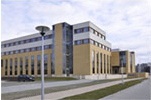7. and 8. Spectral action in Noncommutative Geometry
|
Polish supervisor:
|
Andrzej Sitarz
|
|
Cooperating partners:
|
Bruno Iochum (CNRS Luminy, Universite de Provence, Marseille)
Raimar Wulkenhaar (Universitat Munster)
|
Noncommutative Geometry is a modern branch of mathematics, which
offers the extension of the tools and methods of differential
geometry to the realm of operator algebras. Besides typical
mathematical applications, which are concentrated mostly around
the index theorem and calculation of topological invariants,
noncommutative geometry has a very close link to modeling of
fundamental physical interactions. Its most significant success is
the reproduction of the action principle, which is the core of
current particle physics and general relativity, directly from the
spectrum of the Dirac operator. The spectral action principle,
proposed first by Connes and Chamseddine, gives a correct
description of both general relativity alone (reproducing the
Einstein-Hilbert action with the cosmological constant) as well as
the action for fundamental interactions of particle physics with
the Higgs field and minimal coupling between gravity and particle
fields. The aim of the project is to investigate the spectral
action in the physically relevant cases of product geometries
(product of a manifold with a finite algebra) and in the available
models of noncommutative geometries. The recent preliminary work
on the noncommutative geometries with torsion suggest that in the
general framework the torsion terms appear. Therefore, the first
aim (NC1) would be to calculate the torsion contribution and the
its coupling to physical fields obtained from the spectral action.
Since in the standard Riemannian geometry torsion is set to zero,
we shall either be able to develop the notion of noncommutative
Riemann-Cartan Geometry or determine why torsion terms could be
dropped. Further analysis shall be devoted to the calculation of
similar effects for the purely noncommutative geometries. The
techniques in the first case are based on the heat kernel
asymptotic expansion of Laplace-type operators for manifolds
(Gilkey-Seeley-DeWitt coefficients), whereas in the purely
noncommutative situations the techniques involve explicit
computation of the expansion using the spectrum of the Dirac
operator and advanced operator algebraic techniques (generalized
traces).
In a mathematical formulation the aim is to verify the conjecture
that torsion does not influence the dynamics obtained from the
spectral action.
The second proposed task (NC2) is to investigate the anomalies in
fundamental physical theories (gauge theories and gravity) through
the spectral action. Anomalies occur as a fundamental and direct
geometrical effect in physical theories and represent the
variation of the quantum effective action with respect to symmetry
transformation of classical theories. Therefore, using the
spectral action we have a direct access to it. In particular, we
would like to understand the notion of anomalies as at appears in
the pure noncommutative formulation, especially in the case when
classical Lie-type symmetries are replaced by quantum symmetries
(Hopf algebras). To study it we do have a perfect setting: a batch
of examples of spectral geometries with Dirac operators (quantum
spheres in dimensions 2,3 and 4, Moyal deformation, Noncommutative
Tori) which are equivariant with respect to quantum symmetries.
Mathematically formulating the problem: we want to verify the
conjecture that symmetries (irrespective of whether classical and
quantum) determine anomalies through the spectral action.
|




|
|



